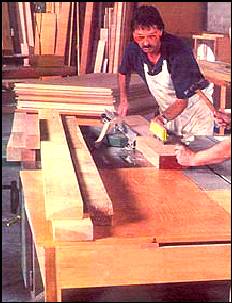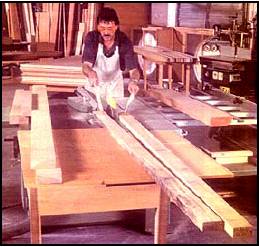Cabinetman
Established Member
Dingleberry? Not a follower of YouTube. Probably why I’ve got all my fingers lol.

There is some irony seeing dingleberry demonstrating bad practices while using a SawStop. It will save him from his stupidity but most of his followers that don't have one will get hurt.
Pete
What is the best operator safety practice for the length of a table saw fence. should it stop at:
Accepting that a riving knife will be immediately behind the blade and a reasonably substantial crown guard will be used AND 2 x longish pushsticks in use.
- start of cut (i.e.) just in front of saw teeth
- middle of saw blade
- end of saw blade (i.e.) just in front of rear teeth
What practical considerations determine your advice.
BTW I am attracted/tempted to the use of a long fence even reaching into my neighbours yard!!! but I am also worried about safety.
Basically set the short fence so that the workpiece goes free as soon as soon as the cut is completed. Then flip it out the way with your push stick or it may foul the movement of the next piece coming through.What is the best operator safety practice for the length of a table saw fence. should it stop at:
Accepting that a riving knife will be immediately behind the blade and a reasonably substantial crown guard will be used AND 2 x longish pushsticks in use.
- start of cut (i.e.) just in front of saw teeth
- middle of saw blade
- end of saw blade (i.e.) just in front of rear teeth
What practical considerations determine your advice.
BTW I am attracted/tempted to the use of a long fence even reaching into my neighbours yard!!! but I am also worried about safety.





Are you saying that woodworking has been infiltrated by the dreaded influencers. One giveaway is their spotless working enviroments, no sign of dust and everything neatly stowed away in pretty plastic boxes.But most of us on here probably also would have to admit that pretending to be a woodworker and making videos 95% of the time vs. the other way around isn't very palatable.
Perfect benches is another giveaway! Though many of them start that way of course, but that's just about excusable!Are you saying that woodworking has been infiltrated by the dreaded influencers. One giveaway is their spotless working enviroments, no sign of dust and everything neatly stowed away in pretty plastic boxes.
Well I can see exactly where you’re coming from Jorny, there really shouldn’t be a controversy but people are being infected with quite expensive and dangerous push blocks etc shown and promoted on YouTube. To be able to use the push block you usually have to remove the crown guard and your hands pass dangerously close to the blade, when there is a kickback it’s a trip down to the hospital usually. IanI don't understand. Is there a controversy surrounding push sticks?! I thought that it was obvious that using push sticks is a good idea.
People used to post up pictures of cut fingers etc but then get irritated when it was suggested that they should have used push sticks.I don't understand. Is there a controversy surrounding push sticks?! I thought that it was obvious that using push sticks is a good idea.
It seems very cynical to push expensive and dangerous products where some simple and cheap push stick would do.
It's the North American way. For some reason many users there are convinced that a long fence is essential, and that a rip saw works best when all the guards are removed, i.e., the riving knife or their inferior splitter and the crown guard. The they tend to believe (erroneously for the most part) they can control a piece of wood that wants to kickback with a shoe type push stick which, during the latter stages of a rip cut, places their hand very close to the exposed spinning blade.It seems very cynical to push expensive and dangerous products where some simple and cheap push stick would do.


How true, please take this as a little English leg pulling. I’ve seen one of your vids David! Let’s just say you certainly don’t set your stall out like the others.
Seems a lot more genuine btw. Ian
2 push sticks in use I see!It's the North American way. For some reason many users there are convinced that a long fence is essential, and that a rip saw works best when all the guards are removed, i.e., the riving knife or their inferior splitter and the crown guard. The they tend to believe (erroneously for the most part) they can control a piece of wood that wants to kickback with a shoe type push stick which, during the latter stages of a rip cut, places their hand very close to the exposed spinning blade.
I think the attitude comes from the tendency of North Americans to think of their saw as a multifunction tool, something that's not common here. A tool, in other words, that can be adapted to act as a sort of spindle moulder where the long fence can be a useful supplement for that use. They also use commonly use dado blades for cutting housings, rebates and the like. Then there's somewhat dodgy practice (in my opinion, anyway) of creating cove cuts in solid parts by passing the wood over the saw blade at an angle using angled fences to trap the wood. The idea is to do multiple passes and to raise the blade a little for each pass until the cove is formed. The common theme is that to undertake most of the alternative functions fairly common in North America requires removal of the splitter (or riving knife) and the crown guard: once removed, those safety items usually remain removed and gather dust in a drawer or simply get lost.
A couple of decades ago I collaborated with a lady called Barb Siddiqui on this article discussing table saw use. It discusses some of the issues in this thread from both an American and European perspective. The poor quality snaps below (sorry) come from that. Slainte.

